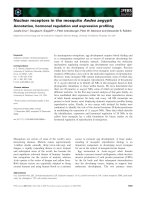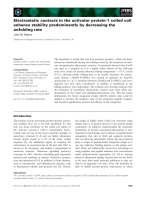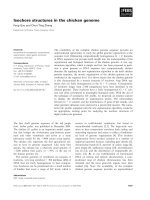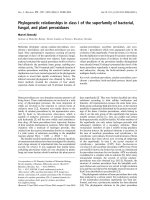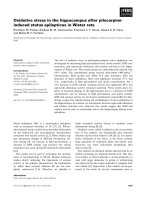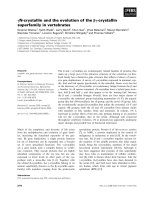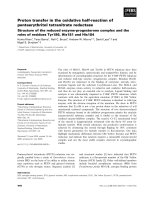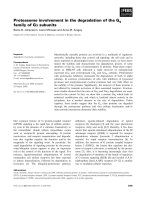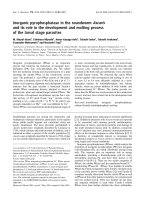Báo cáo khoa học: "Case Revisited: In the Shadow of Automatic Processing of Machine-Readable Dictionaries" ppt
Bạn đang xem bản rút gọn của tài liệu. Xem và tải ngay bản đầy đủ của tài liệu tại đây (141.89 KB, 2 trang )
Case Revisited: In the Shadow of Automatic Processing of Machine-Readable
Dictionaries
Fuliang Weng
Computing Research Lab, New Mexico State University
Las Cruces, NM 88003
This paper discusses the work of automat-
experiencer;
if a person who uses this concept
ically extracting Case Frames from Machine- believes that
seeing
is a process of active selec-
Readable Dictionaries based on a three layer tion, then this person will assign to its subject,
a posteriori Case Theory[5]. an active Case such as agent.
The theory is intended to deal with two 3. context layer: in this layer, Cases
problems:
1. To dynamically adjust grains of Cases.
This is where a posteriori comes from.
2. To provide a procedure to determine
Cases. This is where three layer comes from.
The three layers are:
1. base layer: This layer is intended to ac-
complish transformations of words to concepts
by explicating language and word specific im-
plicants, e.g., for the verb eat in the intran-
sitive case, its subject is eater, while for verb
break in the intransitive case, its subject is the
broken.
2. default layer: in this layer, implicit as-
sumptions of naive theories are made explicit,
e.g., for concept see, there are two different
views towards its subject: if a person who uses
this concept believes that seeing is just a pro-
cess of passive perception, then this person will
assign to its subject, a passive 1 Case such as
*I would like to express thanks to Dr. L. Guthrie,
Dr. D. Farwell and Prof. Y. Wilks for comments and
encouragement. This project is supported in paxt by
CRL. Some of the ideas were developed during my stay
in CS/Fudan and CMT/CMU.
1The words
passine/'acti~e are
used to indicate dif-
ferent levels of activeness. In what follows, Cases
such as agent and instrument have somewhat different
meanings than the conventional ones. We use them
just for referring to a group of phenomena which are
related to their names.
are further clarified upon any requests from
current tasks, associated context and personal
belief systems (knowledge), e.g., in sentence
The commander forced the soldier to break the
door., whether the soldier should be assigned
agent, instrument, active, or something else,
should be decided by both contextual infor-
mation and needs.
Arguments for the three layer theory can be
found in[5].
Relevant knowledge sources for arriving at
different layers are:
1. Formation of the base layer: the for-
mation is based on knowledge sources which
mainly come from syntactic codes and def-
initions in LDOCE (Longman Dictionary of
Contemporary English). Examples in LDOCE
also contribute to this process [1].
2. Formation of the default layer: the for-
mation is based on the assumption that naive
theories are weakly consistent, which implies
that certain semantic classifications may be
consistent with certain naive theories: verb,
noun, preposition and adjective classifications
based on semantic and pragmatic codes in
LDOCE, and examples in LDOCE can help
to obtain such theories.
3. Formation of the context layer: the
unification of the base layer and the de-
337
fault layer forms an initial representation of
the context layer, its further development
mainly depends on task, contextual needs and
personal belief systems. The initial repre-
sentation is a tuple with three components:
entity-role, environment and endurance. An
example of an initial representation for
break
is: ((+) (u-) (0)) break ((-) (u-) (0)), where
(+) stands for active, (-) for passive, (u -) for
indexing of the internal environment, (0) for
duration. If the task is MT, the requirement
for understanding could be shallow as pointed
out by Wilks [7], although he did not discuss
any dynamic grain adjustment. Contextual in-
formation can be conveyed by active features
Following the boot-strapping principle, we
are starting with 750 genus verbs in the defin-
ing word list of LDOCE, then gradually ex-
panding them to all the verbs defined in
LDOCE.
There are various subtasks associated with
this work:
1. Dynamically adjusting classifications of
relational concepts (mainly reflected by verbs):
we are trying to get a set of core verbs as proto-
types of classes based on certain statistics and
genus verb sense nets (the latter is being con-
structed by G. Stein). A primary set of core
verbs have been chosen, functional verbs are
carefully prevented. The criterion for dynam-
ically adjusting verb classes is: Cj (d) = (y :
II
y-z
H< d,z E
Cj),
where
C i are
core classes
and II • II is
defined as:
II y-x U =
mini( i
is the
numbers of links on P, P is any path connect-
ing x and y }. We can select a reasonable dis-
tance for
Cj(d)
by detecting slopes with points
in the distribution of members. Classification
can also be done within connectionist models.
2. From the prototypes, naive theories may
be formed, and then converted into represen-
tations in the default layer.
3. Dynamic creation of Cases. Initial rep-
resentations in the context layer may be ad-
justed and new Cases be created according to
a set of contextual conditions (mainly when
mismatches happen).
4. A set of rules can be constructed to get
the conventional Cases for typical situations.
Many Case Theories are focused on verbs.
In our situation, all the four major cate-
gories (verb, noun, adjective and preposition)
must be paid enough attention to, since there
are many verbs defined by verb phrases in
LDOCE. e.g., a definition entry of verb
take
in LDOCE contains
get possession of.
In or-
der to select a right Case frame and verb class
for each verb, we need something beyond what
we have presented although it does not con-
flict with what we have proposed and it is very
plausible that the procedure used here may be
adapted to establish Case frames for nouns,
adjectives and prepositions. This task may be
benefited from [2].
References
[1] B. Atkins et al, Explicit and Implicit In]ormation
in Dictionarien, CSL Report 5, Princeton Univer-
sity, 1986.
[2] R. Bruce and L. Guthrle, GenuJ Disambiguation:
A Study in Weighted Prelerenee, MCCS-91-207,
CRL/NMSU, 1991.
[3] C. Fillmore, The Ca~e ]or Case,in Uni~ersab in
Linguistic Theory, E. Bach and R. Harm (eds.),
Holt, Rinehart, and Winston, 1968.
[4] R. Schank, Coneeptaal Information Processing,
North-Holland Publishing Co., 1975.
[5] F. Weng, A Three-Layer a posteriori Ca~e The-
07, in preparation, 1991.
[6] W. Wilkins, Syntaz and Semantics, Academic
Press, Inc., California, 1988.
Y. Wilks, An Artificial Intelligence Approach
to
Machine Translation, in Computer Models o]
Thoaght 6nd Language, R.Schaak and K.Colby
(eds.), W.H.Freemaa Co., 1973.
338
